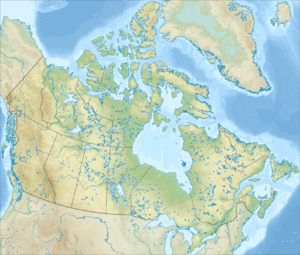Coppermine River
| Coppermine River | |
|
View of the Arctic Sea from the mouth of the Coppermine River (1821) by George Back
|
|
| Country | Canada |
|---|---|
| Source | Lac de Gras |
| - location | Northwest Territories, Canada |
| - elevation | 396 m (1,299 ft) |
| - coordinates | 64°35′01″N 111°11′33″W / 64.58361°N 111.19250°W |
| Mouth | Coronation Gulf |
| - location | Nunavut, Arctic Ocean, Canada |
| - elevation | 0 m (0 ft) |
| - coordinates | 67°48′43″N 115°05′05″W / 67.81194°N 115.08472°WCoordinates: 67°48′43″N 115°05′05″W / 67.81194°N 115.08472°W |
| Length | 845 km (525 mi) |
The Coppermine River is a river in the North Slave and Kitikmeot regions of the Northwest Territories and Nunavut in Canada. It is 845 kilometres (525 mi) long. It rises in Lac de Gras, a small lake near Great Slave Lake and flows generally north to Coronation Gulf, an arm of the Arctic Ocean. The river freezes in winter but may still flow under the ice.
The community of Kugluktuk (formerly Coppermine) is located at the river's mouth.
The river was named for the copper ores which could be found along the lower river. Samuel Hearne travelled down the river to the Arctic Ocean in 1771. Sir John Franklin also travelled down the river during the Coppermine Expedition of 1819–1822. In 1826 its mouth was reached by John Richardson who followed the coast from the Mackenzie River.
Bloody Falls, part of the Kugluk/Bloody Falls Territorial Park, is located 18.5 kilometres (11.5 mi) from Kugluktuk, and was home to the Kogluktogmiut a sub-group of the Copper Inuit. It is the site of the Bloody Falls Massacre, when Matonabbee, Samuel Hearne's guide, and his fellow Chipewyan warriors ambushed and massacred the local Inuit.
...
Wikipedia


